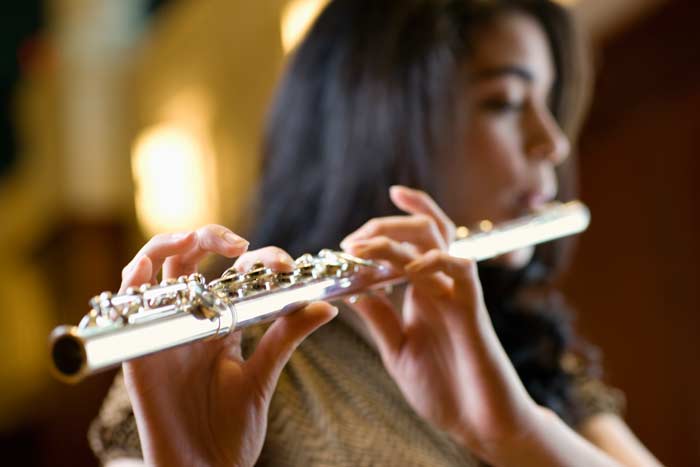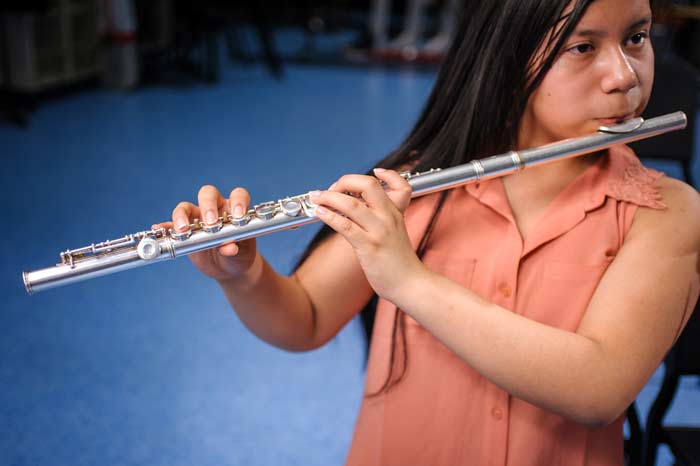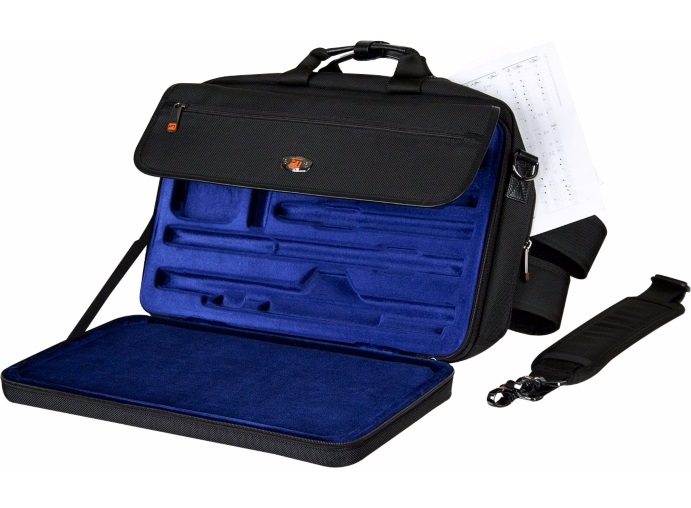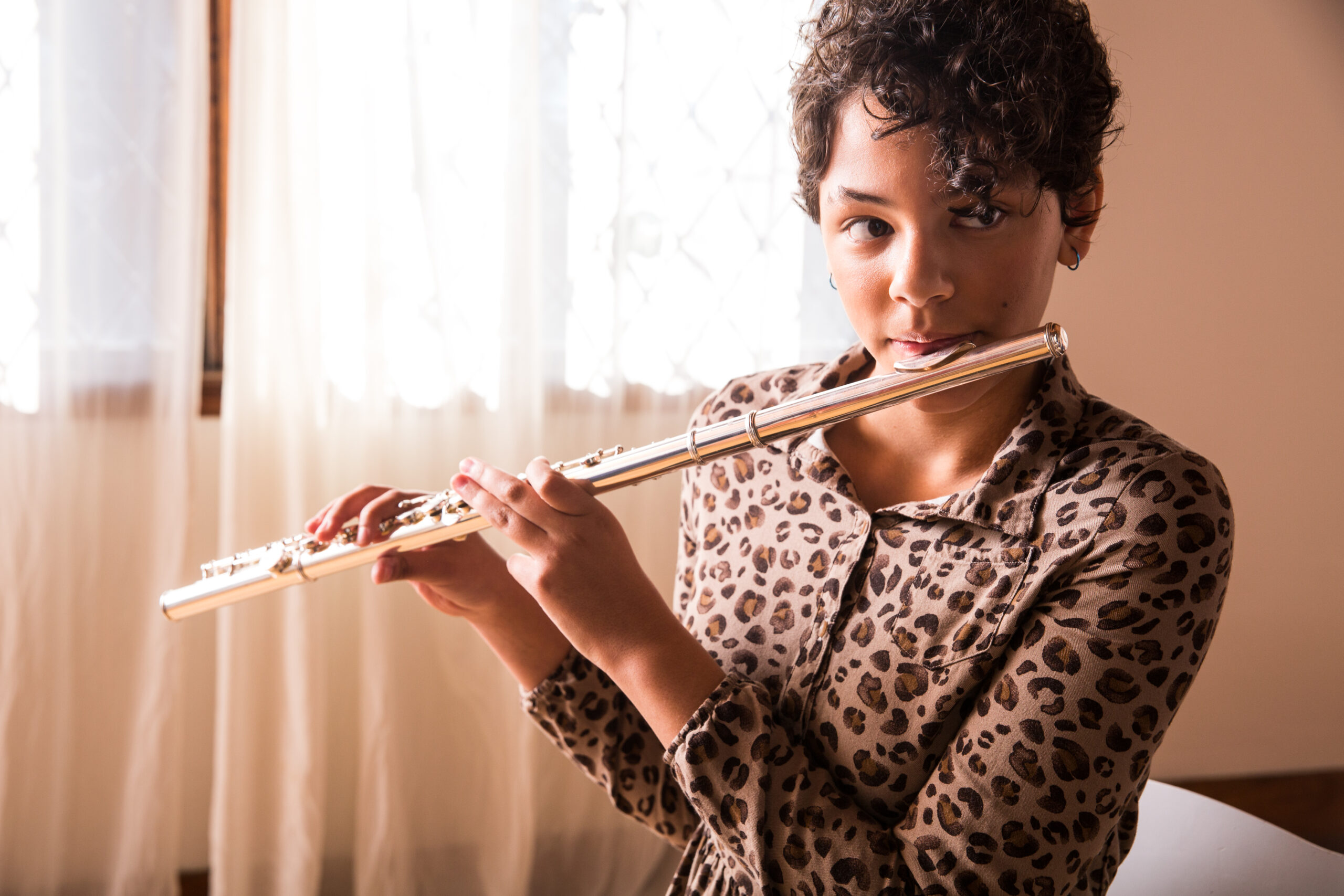July 06, 2015
Flute Buying Guide


Flute Buying Guide
The flute is one of the most recognizable instruments in the world, not to mention having an incredibly long history. With all that time, and the changes and improvements made year-over-year, it’s evolved into a surprisingly complex instrument despite its small size. The intricacy of the flute may be daunting if you’re a first-time buyer, but don’t be intimidated: with a quick read-through of this guide, you’ll know the general information needed to make a smart choice for your first instrument. And if you’re an experienced player already, then consider this a great opportunity to brush up on the basics.
Parts of a Flute
Headjoint
An essential component of every flute, the headjoint is the piece that a musician blows air into to create sound. They are most commonly manufactured from silver, but are also available in nickel, gold, platinum and wood. The headjoint also contains the tuning cork, which plays an important role in achieving the flute’s proper pitch.


Body
The body of the flute is the largest section of the instrument. It houses most of the keys and connects to both the headjoint and the footjoint. The body is where you’ll find the tuning slide and tenons, which are used to tune the flute.
Footjoint
The smallest section of the flute, the footjoint contains several keys. Student flutes come with a standard C foot that has the Eb key, the C# key and the C key. Intermediate and professional flutes are outfitted with B foot joints that feature an extra key on the end. This extra key extends the range of a flute downward to B3.
Body Materials
Nickel-silver – An alloy of cooper, zinc and nickel that is often used in student flutes. Nickel-silver has a low density, is very resilient and produces a tone that light, clear and responsive.


Silver – The most commonly used material in flute making, silver flutes are known for its pure tone and light, fluid sound. Its heavier weight makes it the metal of choice among intermediate and professional musicians. Solid silver requires extra care when handling and is best suited to flutists who have developed the skills and routine to properly maintain their instrument.
Gold – More dense than silver, flutes constructed with gold blends are prized for their warm tone. While gold by itself is a very soft metal, when combined with other metals like copper and silver, it creates a stable alloy that produces a warm, dark sound.


Plating Materials
Nickel – Commonly used in beginner flutes, nickel plated flutes feature a hard composition that makes it easy to care for and clean. Lighter in weight than most other materials, nickel produces a sound that is crisp and bright.
Silver – Heavier in weight, silver plated flutes have a darker sound than nickel flutes. It adds a bright shining finish to the flute. Almost all intermediate and professional flutes, as well as some student models, are silver plated.
Gold – Offering a warm and colorful tone, gold plated flutes are a great alternative to nickel and silver. It provides extra traction for the bottom lip and is helpful to musicians who are playing fast passages. The preferred choice of many professional musicians, gold has a higher price tag than most materials.
Special Flute Keys
Inline or Offset G
The G key is played with the third finger of the left hand, and the G keys on the flute can be made inline or offset. There is no tonal difference between inline and offset G keys; they are designed simply for comfort and playing preference. Inline G keys are set in a straight line beside the rest of the keys on the flute and are all mounted on the same section. They are traditionally found on intermediate and professional flutes. Offset G keys are mounted on separate posts and are offset slightly from the rest of the keys. Musicians with smaller hands and shorter fingers may prefer this key positioning as it makes the keys slightly more accessible.


Plateau-style keys
Designed for less advanced fingering techniques, plateau-style keys are often found on student flutes. They are usually constructed with an offset G to give beginners easier access to the keys.
French-style keys
Also known as the “open hole” model, French-style keys feature holes in five of the center keys on the flute. These keys are said to give the flute a slightly clearer, louder sound as the air vibrations are less muffled. The French model usually has an inline G key which guides the left hand into a vertical position, encouraging proper fingering technique for student players.
Differences Between Student, Intermediate and Professional Flutes
If this is your (or your child’s) first foray into playing the flute, your first instinct may be to buy the least expensive instrument available. However, this plan may backfire and result in frustration and unnecessary stress for everyone involved. A higher quality flute offers greater clarity, better intonation and easier playability – all factors which are extremely important to an inexperienced flutist. Your best bet is to take the time to familiarize yourself with brands and models at a variety of price points to determine which flute will suit your musical needs.
Student Flutes
Typically crafted from nickel with silver-plated plateau keys, student flutes are designed especially for first-time flutists. Because children have smaller hands, some beginner flutes have curved headjoints that extend the player’s reach. This allows better access to keys along the flute’s body for students with shorter reach.


Intermediate Flutes
A step above student or beginner models, intermediate flutes cater to musicians who have mastered the basics and ready for a new challenge. An intermediate, or “performance,” flute features a solid silver headjoint and silver plated body which brings a rich tone and texture to your sound. They frequently have a B footjoint, and almost always have a French or open hole key design.


Professional Flutes
A flute that is labelled “professional” will come with a higher price than that of a beginner or intermediate model. Main differences between intermediate and professional flutes include: use of top-quality metals in production, the option of soldered or drawn tone holes and improved precision in the springs and pointed key arms.


To Rent or not to Rent
There are a couple different options when it comes to choosing a flute: the first is whether to rent or buy your instrument. Any investment you make will be significant, and with instrument prices ranging from a couple hundred to thousands of dollars (and more) it’s best you research all your options before making a final decision.
If you’re nurturing the musical interests of a young musician, you should look into a rental. Children have a tendency of changing their minds quite frequently and with a rental, you can exchange your flute for a different instrument at no extra cost. In addition, many programs are rent-to-own, meaning as you make regular rental payments you are earning credit towards owning the instrument over time. In some rent-to-own situations, you can even use this credit towards the purchase of a professional-level flute if your child decides to continue playing into high school. Lastly, you should consider the fact that your child’s flute may get damaged. From regular wear and tear to complete replacement, damage coverage will ensure their instrument stays in tip-top shape. Damage coverage is typically available from the rental provider for a low monthly fee, and it’s definitely worth the additional charge considering student instrument values range from $500-$2000 – a substantial amount of cash to spend on a new flute.
Now, if you’re looking for a flute for yourself or an advanced young musician (high school age or older), it’s best to buy a flute outright as it will be a less expensive investment in the long run. If you do decide to buy, make sure to thoroughly research your instrument before purchasing. Online and in-store research and instructor/professional recommendations will be your best friends when it comes to selecting the best instrument for your skill level and budget.
New or Used?
As it was previously implied, buying a flute is the way to go if you’re already well-acquainted with the instrument. It’s critical to do your research before making your ultimate purchasing decision – especially if the flute is second hand. Be wary of auction or local seller sites where the return policy isn’t strong, as they may leave some information to be desired. Whether you buy new or used, consider these factors: Does this instrument come with a warranty? Does the company/seller offer a parts replacement program? What about in store repairs? By answering yourself these questions, your decision will be a lot easier.
Of course, there’s no right or wrong way to go when it comes to buying new or used – in fact, you’ll find plenty of exceptional deals on second hand flutes in this day and age. Either way, just keep this guide in mind during your search, and you should have no problem finding a flute that perfectly matches your personal preferences.
Caring For Your Flute
Whether you’re a beginner or professional flutist, proper care of your flute is essential to the longevity of its parts and overall durability of the instrument. Here are a few tips that will keep your flute in the best possible condition.
- Proper storage – Buy a case for your flute. Ensure that, after every practice session and performance, it is taken apart carefully and put in its case. If storing your flute for a long period of time, make sure it is in a temperature-controlled area. Exposing your flute to extreme heat or cold will have an effect on its sound.
- Make sure your mouth is clean – This may seem trivial, but since woodwinds require you to blow through them, your mouth should be free of food particles and sugary liquids before you play. This will increase the longevity of your lip plate and pads.
- Swabbing – Your flute will come with a cleaning cloth and needle. It is very important to make sure your flute is dry on the inside (and outside) before putting it away for storage. Feed the tip of the cloth through the needle and pass it through each of the three parts of the flute. Pay extra attention to the headjoint- it contains the cork and you could easily break its seal if you swab too vigorously.
- Sticky keys – Even if your mouth is completely clean and you thoroughly dry your instrument after each use, your keys may still stick from time to time. This is simply due to humidity in the air. Periodically blowing sharp bursts of air over them may be a quick fix to this problem. If your keys continue to stick, try inserting a clean piece of paper under them and pressing very lightly to remove the moisture. Like swabbing, you must pay very close attention to your technique with sticky keys, as the pads underneath them are fragile and replacing them can be expensive.
- Assembling and disassembling – Repairs to a flute can be very costly, so it is very important to follow the proper steps when putting together or taking apart your flute. The flute should never be held by the keys or mechanism. Its pieces should slide together with an easy twisting motion and should never be forced into one another. The footjoint goes into the body first, then the headjoint using the first key as a reference point for the embouchure hole.
Careful maintenance will help your new flute last as long as possible, so be sure to stock up on all the accessories you’ll need to take care of it. After all, when you take the rest of this guide into account and use your newfound knowledge to choose the right instrument for your needs, you’ll definitely want to protect your investment to help you along your musical journey. The flute is a beautiful instrument that’s fun and rewarding to learn – and there’s no better time to start than right now.






